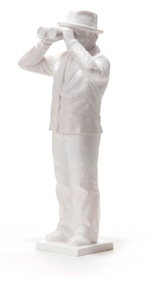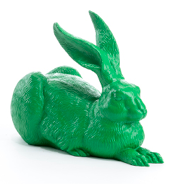
Ihr Warenkorb ist leer.


Ihr Warenkorb ist leer.

One of Wagner's early ideal conceptions was that of opera for everyone. At his time, such a concept was a revolutionary idea that was ultimately unrealisable in view of the prevailing conditions. Ottmar Hörl is taking up Wagner's idea against the background of today's options provided by electronic and technical reproducibility. Hörl transfers the venue of his "opera for everyone" into the automobile, which has become an ordinary commodity of modern times. Hörl's concept involves eight Smart compact cars being presented in varying arrangements in the city centre of Bayreuth to accompany this year's Wagner Festival.
The cars are labelled "Opera Houses for the 21st Century". They will be open during the day and passers-by are invited to get in and listen to Wagner operas. The repertoire at the "Opera Houses for the 21st Century" corresponds to that at the Wagner Festival. "As we tend to spend so much time in our cars," Hörl says explaining his conception, "cars are usually very well equipped: comfortable seats, agreeable interior equipment, plus a top-notch audio package. Considering the good acoustics of the passenger compartment to boot, one may say that the acoustic experience inside an automobile is excellent."
The Richard Wagner’s Dog Russ sculptural project commemorates Richard Wagner as an animal lover, visualising the composer's humaneness as expressed in the relationship between man and animal. Ottmar Hörl comments: "Chroniclers have failed to portray Richard Wagner as a likeable person. My intention is to make Wagner tangible beyond the star cult, take him away from his artistic Olymp and make him palpable."
An emblem of man's sympathy and compassion, Wagner's dog points to Richard Wagner as an amiable man who is part of an ordinary social structure – the same that is true for every human being. Richard Wagner had close ties to nature all his life. Walking and hiking – and seeing the world as a great cohesive system – were a great source of inspiration to him. The dogs were his companions and part of his life. This close connection with animals is evident in all periods of Wagner's life. It has been documented in the letters Wagner exchanged with Minna Wagner, Mathilde Maier and Mathilde Wesendonck as well as in Cosima Wagner's diaries. In a letter written to Ernst von Weber in 1879, Wagner explicitly condemns the "torture chambers of science", which makes him an early campaigner against animal experiments. During the Wagner Festival, Hörl's project involves 800 life-size Newfoundlands – Wagner’s favourite dog breed – guarding every single park bench within Bayreuth city limits.
Franz Liszt was one of Richard Wagner's most notable supporters. The two men were connected by deep friendship lasting almost thirty years – although, at times, this bond was clouded by quite a few misunderstandings. When Wagner was politically prosecuted during the Revolution of 1848, Liszt assisted him to flee Dresden and, in difficult times, championed the premiere of Lohengrin at the Weimar Theatre, amongst other things. Ottmar Hörl dedicates to this personal attachment between Richard Wagner and Franz Liszt, his father-in-law, an art project presented at the Bayreuth Municipal Museum during the 2004 Wagner Festival. In a project room, Hörl will be showing a series of six Wagner heads mounted on pedestals and spinning round their own axes. The centre of the room will be taken up by one stationary bust of Franz Liszt, who – calm and balanced – observes the rotating Wagner heads. The room is filled with a background humming, an allusion to the process of composing music. To Ottmar Hörl, Wagner and Liszt were two antipodes that could hardly have been more divergent and yet they attracted each other. A calming influence, Franz Liszt is opposed to a restless, questing Richard Wagner, with Liszt ultimately stimulating his son-in-law's oeuvre.